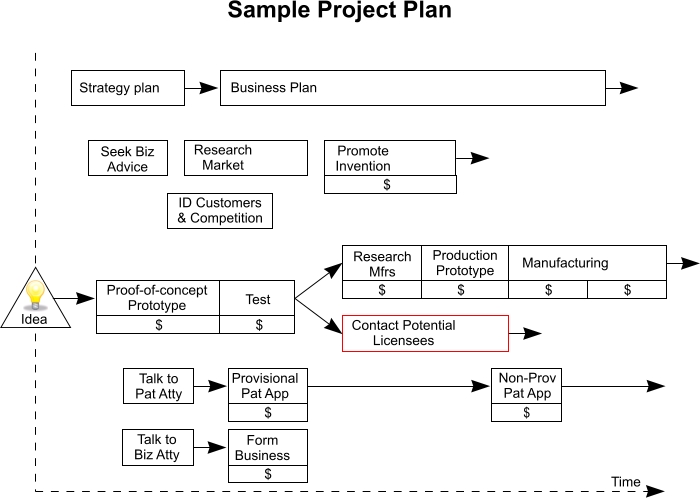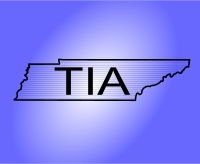November 2010 Elections and Project Planning
The agenda for the November 20 TIA meeting iincluded our annual elections and presenting part three of the business plan. Part 3 of the inventor's business plan is the Project Plan. The steps required to move from inventing to making money need to be identified, along with the expected costs and schedule.
Tom Kulaga introduced the third section of the inventor’s business plan. A business plan for inventors has the following sections:
The Business Plan
1. Description of the business
2. Marketing plan
3. Project management plan
a) Overview
b) Startup Schedule
c) Operating Schedule
4. Management plan
The Project Management Plan
The Overview contains a short description of the tasks and the costs of developing, starting, and operating the venture.
The Startup Schedule identifies all the tasks and their associated costs for starting the venture. The Startup Schedule includes everything from conceiving the invention up through finding a licensee or starting manufacture. All the tasks needed to start up the venture are identified, as far as they are known at any time. The table below identifies generic tasks that may apply for inventors who wish to license their invention and for inventors who wish to manufacture and sell products.
| Licensing the invention | Making and selling a product |
| Build proof-of-concept prototype Test prototype Build production prototype Test prototype Identify customers Investigate market Identify the competition Seek patent and trademark advice Seek business advice File provisional patent application File non-provisional patent application Obtain funding Promote invention/product (press releases, articles) Contact potential licensees
|
Build proof-of-concept prototype Test prototype Build production prototype Test prototype Identify customers Investigate market Identify the competition Seek patent and trademark advice Seek business advice File provisional patent application File non-provisional patent application Obtain funding Research manufacturers Research distribution channel Promote invention/product (press releases, articles, trade shows) Advertise |
After the tasks are identified, when they are to be performed and their associated costs need to be determined and evaluated. Tom presented a sample chart showing one way the various tasks would be performed over time. Each of the steps shown below are made of sub-steps. The level of detail desired is up to the inventor. Identifying all the sub-steps often helps with planning what needs to be done to commercialize an invention.
After the steps of building the proof-of-concept prototype and testing it, the project plan branches. The upper branch applies to those who wish to manufacture and sell products. The lower branch applies to those who wish to license their patent.

The Operating Schedule is similar to the Startup Schedule except that it focuses on the ongoing activities and tasks of a going venture. If the business is to manufacture and sell products, the operating schedule may identify locating new suppliers and manufacturing facilities as the volume grows over time. It may also include tasks relating to developing new products or improving the existing product.
Carl Papa and the Pin High Pro
Carl Papa is working on his business plan. Carl presented information on his project management plan. In particular, he discussed the Promote Invention step shown on the chart above. Last August, Carl had the opportunity to participate in the Knoxville News Sentinel Open Golf Tournament. He had a tent set up with other vendors at the tournament. In order to prepare for the Tournament, Carl identified several things that needed to happen.
Originally, Carl hoped to be able to sell his golf training aid invention, the Pin High Pro, at the Tournament. After he identified all the steps that needed to be completed, he realized that it was not possible to complete all those tasks. Many of the manufacturing tasks had to be done in sequence and their completion required others, like the manufacturer, to do things within a short time.
When Carl went through the process of identifying and evaluating all the tasks that needed to happen before the Tournament, he reconsidered what he could do at the Tournament. Instead of selling his product, he had final prototypes available as demonstration units. Carl said that if he had finished products to sell, he could have sold a bunch. He was able to collect many names of potential customers, which he will contact as soon as he has product ready to sell.
Another aspect of his invention promotion program is marketing his invention on the Internet. Carl also showed his website and how he plans to promote his invention and product to potential buyers on the Internet. His website has videos showing how the invention is used and why it will help golfers. He is also using social networking tools, like Twitter and Facebook, to promote the Pin High Pro.
Tennessee Inventor Association Annual Election
Elections were held during the November meeting, which is our Annual Meeting. Additional nominees were nominated at the meeting before voting began. We had several positions to fill. Igor Alexeff was nominated for Vice President. Mike Campbell was nominated for Recording Secretary. Three Board of Directors positions were vacant and Carl Papa, Gordon Campbell, and Holly Shaw were nominated. All positions were uncontested and everyone nominated was elected.
The following table shows the results of the elections.
| Officers | Elected |
| President | Tom Kulaga |
| Vice-President | Igor Alexeff |
| Treasurer | Ann Alexeff |
| Recording Secretary | Mike Campbell |
| Corresponding Secretary | Martin Skinner |
| Board of Directors | Arnold (AJ) Beal |
| Carl Papa | |
| Gordon Campbell | |
| Holly Shaw |
- Login to post comments

